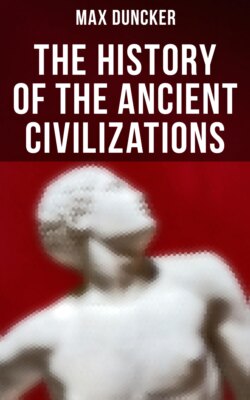Читать книгу The History of the Ancient Civilizations - Duncker Max - Страница 13
На сайте Литреса книга снята с продажи.
FOOTNOTES:
Оглавление[130] Diod. 1, 12, 45.
[131] Herod. 2, 99.
[132] Diod. 1, 50. He ascribes the foundation of the city to a later king, whom he calls Uchoreus.
[133] Strabo, p. 808; Tac. "Ann." 2, 6.
[134] Lepsius asserts that he found traces and remains of sixty-seven pyramids. "Briefe aus Ægypten," s. 65.
[135] Lepsius, "Abh. der Berl. Akad." 1843, s. 177 ff.
[136] Bœckh, "Metrologie," s. 236.
[137] Herod. 2, 124–127, 134.
[138] Diod. 1, 63, 64.
[139] Brugsch, "Hist. d'Egypte," p. 35.
[140] Cf. Strabo. p. 809.
[141] Lepsius, "Chronologie," s. 248, 302. Gutschmid has supported the Herodotean inscription on the strength of papyri from the times of Ramses Miamen in Philologus, 10, 644; the "talents" in any case must be left for the dragoman.
[142] Lepsius, "Denkmale," 3, 2, plate II.
[143] De Rougé, "Monuments des six premières dynasties; Mémoires de l'Institut," 1856, 25, 265 ff.
[144] Lepsius, "Denkmale," 3, 2, plate II.
[145] Brugsch, "Hist. d'Egypte," p. 113.
[146] Brugsch, "Zeitschrift für aegyptische Sprache," 1864, s. 61.
[147] De Rougé, loc. cit. p. 257.
[148] De Rougé, loc. cit. pp. 282, 283.
[149] Herod. 2, 128. M. Büdinger ("Zur ægypt. Forschung Herodot's." s. 24) identifies this Philitis with the shepherd-king Salatis; cf. infra.
[150] Cf. above, p. 59. Mariette, "Revue archéol." 1860, p. 18.
[151] De Rougé, loc. cit. pp. 281, 307.
[152] De Rougé, loc. cit. p. 267.
[153] De Rougé, loc. cit. p. 328 ff.
[154] "Revue archéolog." 1862, p. 279.
[155] Brugsch, loc. cit. p. 53.
[156] Rosellini, "Monumenti storici," 3, 33. Brugsch, "Hist. d'Egypte," p. 54.
[157] Rosellini, loc. cit. 1, 38.
[158] Brugsch, loc. cit. p. 55, 56.
[159] "Revue archéolog." 1862, p. 297; 1864, p. 69.
[160] Bunsen, "Ægypt." 2, 323; Lepsius, "Chronolog." s. 287.
[161] Lepsius, "Briefe aus Ægypten," s. 259. On the fortifications, De Vogüé, "Athen. franz." Sept. 55, p. 84.
[162] Brugsch, "Hist. d'Egypte," pp. 68, 69.
[163] Lepsius, loc. cit. s, 81; Brugsch, loc. cit. p. 67.
[164] Herod. 2, 13, 101, 149.
[165] Diod. 1, 51, 52. "This is what the Egyptians tell of Mœris."
[166] Strabo. p. 809–811. Tac. Annal. 2, 61.
[167] Lepsius, "Briefe," s. 81.
[168] Linant, "Mémoire sur le lac Moeris."
[169] Lepsius, loc. cit.
[170] Linant, loc. cit.
[171] Herod. 2, 148.
[172] Diod. 1, 89, 66, 61.
[173] Strabo. p. 811; for τείχους μικροῦ we must obviously read μακροῦ, and for ἔχοντες, ἔχοντος.
[174] Strabo. p. 811; cf. 813.
[175] Plin. "Hist. Nat." 36, 19. As the building was actually not more than a stadium square, the statement of Herodotus that there were 1500 chambers above the earth—quite irrespective of the 1500 underground—is inexplicable, unless the chambers were very small. In Pliny we must read 1500 for 15,000.
[176] Lepsius, "Briefe aus Ægypten," s. 74 ff.
[177] Brugsch, "Histoire d'Egypte," p. 63; Ebers, "Die Bücher Mose's," s. 98.
[178] De Rougé in Brugsch, "Hist. d'Egypte," p. 69.
